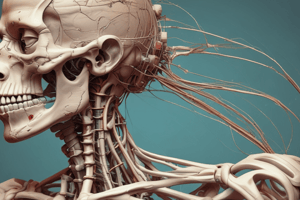Podcast
Questions and Answers
What type of joint is the shoulder joint classified as?
What type of joint is the shoulder joint classified as?
- Pivot joint
- Shallow ball-and-socket joint (correct)
- Saddle joint
- Hinge joint
Which ligaments are components of the glenoid labrum?
Which ligaments are components of the glenoid labrum?
- Coracohumeral ligament and glenohumeral ligaments
- Glenohumeral ligaments and coracoacromial ligament (correct)
- Rotator cuff ligaments and scapular ligaments
- Coracoacromial ligament and acromial ligament
What is the largest bursa within the body associated with the shoulder joint?
What is the largest bursa within the body associated with the shoulder joint?
- Subcoracoid bursa
- Coracobrachial bursa
- Subacromial-subdeltoid bursa (correct)
- Subscapular bursa
Which muscle primarily functions to abduct the arm at the shoulder joint?
Which muscle primarily functions to abduct the arm at the shoulder joint?
What contributes to the deepening of the articular surface at the shoulder joint?
What contributes to the deepening of the articular surface at the shoulder joint?
Which component helps maintain the position of the clavicle in the shoulder girdle?
Which component helps maintain the position of the clavicle in the shoulder girdle?
Which imaging modality is best for visualizing the rotator cuff?
Which imaging modality is best for visualizing the rotator cuff?
Which of the following muscles is NOT part of the rotator cuff?
Which of the following muscles is NOT part of the rotator cuff?
Flashcards are hidden until you start studying
Study Notes
Shoulder Anatomy
- The shoulder is a ball-and-socket joint, the most mobile in the body.
- The shoulder girdle consists of the clavicle, scapula, and humerus.
- Four projections on the scapula serve as attachment points for muscles and ligaments:
- Scapular spine
- Acromion
- Coracoid process
- Glenoid process
Shoulder Labrum and Ligaments
- The glenoid labrum is a fibrocartilaginous ring that deepens the glenoid fossa, the socket for the humeral head.
- The glenohumeral ligaments (three fibrous bands) contribute to the glenoid labrum's formation.
- The coracoacromial ligament protects the humeral head and rotator cuff tendons from trauma.
- The coracoclavicular ligament stabilizes the clavicle.
Shoulder Bursae
- Bursae cushion the tendons and ligaments of the shoulder joint.
- The subacromial-subdeltoid and subscapular bursae are prominent.
- The subacromial-subdeltoid bursa is the largest bursa in the body.
Shoulder Muscles and Tendons
- The deltoid and four rotator cuff muscles provide stability and movement:
- Supraspinatus
- Infraspinatus
- Teres minor
- Subscapularis
- The deltoid muscle's primary function is arm abduction.
- The rotator cuff muscles surround the shoulder joint for stability, abduction, and humerus rotation.
- Oblique coronal MR images provide the best visualization of the rotator cuff muscles.
Studying That Suits You
Use AI to generate personalized quizzes and flashcards to suit your learning preferences.



